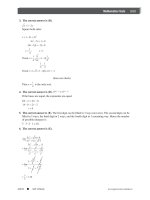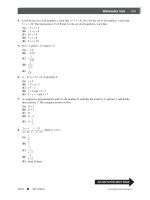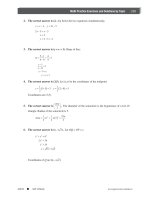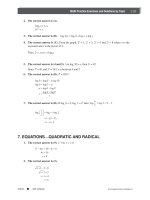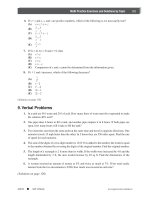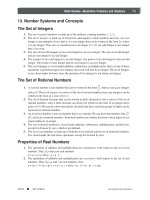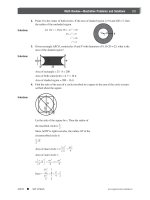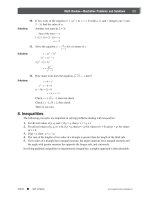SAT II Biology Episode 1 Part 7 docx
Bạn đang xem bản rút gọn của tài liệu. Xem và tải ngay bản đầy đủ của tài liệu tại đây (331.39 KB, 20 trang )
NUCLEOTIDES
The building blocks of DNA, nucleotides are used to make up the
repeating units in the strands of DNA that represent the genetic code.
A nucleotide consists of a sugar, a phosphate, and a nitrogen base.
Since there are only four bases, researchers postulated that the
enormous amount of genetic variation on the planet had to be in the
sequence of the nucleotides within the DNA molecule. This sequence
then controls the synthesis of precise proteins in the sequence of
amino acids. On one end of the DNA molecule, the 5-carbon sugar
has a phosphate attached and is known as the 58 end. On the other
end of the sugar is an OH that is identified as the 38 end of the DNA
molecule.
Bases
Four nitrogenous bases make up the bonding sites along the center of
the DNA molecule and are bonded to a carbon on the sugar mol-
ecule. There are two purines and two pyrimidines. The purine names
end in -nine.
MOLECULAR GENETICS—DNA AND EVOLUTION
117
Peterson’s n SAT II
Success: Biology E/M www.petersons.com
A. Adenine
A purine, double-ring base with two bonding sites
B. Thymine
A pyrimidine, single-ring base with two bonding sites
C. Cytosine
A pyrimidine, single-ring base with three bonding sites
D. Guanine
A purine, double-ring base with three bonding sites
Ribose
A 5-carbon sugar, as signified by the -ose ending, ribose is considered
the central part of the nucleotide, as the bases and the phosphate
bond to it.
Phosphate
Bonded to another carbon on the ribose sugar, the last phosphate on
the molecule is the 58 end.
CHAPTER 5
118
Peterson’s n SAT II
Success: Biology E/Mwww.petersons.com
HISTONES
Histones are proteins that help protect the DNA molecule. The DNA
molecule is surrounded by eight or nine histones to help it form a
protective DNA-histone complex in a tight space in the nucleus.
BASE-PAIRING
Base-pairing is the pairing of complimentary bases along the DNA
strand. The sum of the bonds and the coiling of DNA makes the
molecule securely attached along its entire length. Analysis of the
assays of the DNA from a variety of organisms caused Erwin Chargaff
to note that the percentage of adenine was almost identical to the
percentage of thymine in the DNA of a cell. A similar relationship
was discovered for cytosine and guanine. This was later referred to as
Chargaff’s rule and led Watson and Crick to the ultimate conclusion
that the molecule was directed inward—the result of which was their
proposal that DNA was a double helix. Linus Pauling, who did so
much work with proteins, wrestled with the molecule being directed
outward; many others did as well, based on the strength of Dr.
Pauling’s reputation.
Adenine-Thymine
This purine-pyrimidine bonding is the result of each base having two
hydrogen bonding sites. Adenine and thymine can bond only with
each other in DNA.
MOLECULAR GENETICS—DNA AND EVOLUTION
119
Peterson’s n SAT II
Success: Biology E/M www.petersons.com
Cytosine-Guanine
This purine-pyrimidine bonding in the DNA molecule is the result of
these bases having three sites for hydrogen bonds. Cytosine and
guanine can only bond with each other.
H1 bonds
The bonds between the adenine-thymine and cytosine-guanine classes
of chemicals that form the base sequences in DNA, in addition to
other places where we find hydrogen bonds.
COMPLIMENTARY STRANDS
Since adenine always bonds with thymine and guanine always bonds
with cytosine, if one strand of the DNA molecule is known, then the
other, complimentary strand can be known. This means that if you
have one half of the molecule, you can construct the other half,
which is exactly what DNA does during replication. The main strand
CHAPTER 5
120
Peterson’s n SAT II
Success: Biology E/Mwww.petersons.com
is used as a template to produce its complement. The nature of the
bonds along the strand make the adenines on one strand line up in
the opposite direction of the adenines on the other strand. As a
result, the molecule is said to be anti-parallel.
5* end
“Hanging out” on one end of the base pairs is the phosphate group,
which is the end that starts the “reading” of the molecule when it is
being replicated. The direction of replication along the master strand
then is from 58 end to 38 end.
3* end
Opposite the base on the master strand with its 58 end is the compli-
mentary strand with its 38 end oriented outward at the “beginning” of
this strand, in an anti-parallel way.
REPLICATION
A combination of the words “reproduce” and “duplicate,” replication
refers to the act of DNA making a copy of itself. This precedes
mitosis or meiosis. Mitigated by enzymes, it proceeds as two concur-
rent events, one from the 58 end of what is called the leading strand
and the other from the 38 end of the lagging strand. The result of
replication is said to be semi-conservative, since we end up with half
the original DNA in each of the resulting new strands.
DNA helicase
DNA helicase is an enzyme that begins the unraveling of the DNA
molecule at the sites of the hydrogen bonds.
DNA polymerase
This enzyme arranges the new nucleotides next to their complimen-
tary base to make the new strand of DNA. As the name suggests, it
makes a polymer out of individual nucleotides.
MOLECULAR GENETICS—DNA AND EVOLUTION
121
Peterson’s n SAT II
Success: Biology E/M www.petersons.com
Leading strand
A leading strand is a strand of DNA that starts at the 58 end and is
made continuously. It is not named for the fact that it starts first, but
for the fact that, since it is made continuously, the construction of it
proceeds faster.
Lagging strand
A strand of DNA that starts at the 38 end. Its production proceeds
slower than the leading strand because it is made in pieces that are
then bonded to the template to which it will be complimentary.
These pieces, known as Okasaki fragments, are bonded into place by
DNA ligases.
RNA-RNA
RNA-RNA is a 5-carbon sugar that possesses an extra oxygen atom
[compared with DNA] and replaces thymine with the base uracil,
CHAPTER 5
122
Peterson’s n SAT II
Success: Biology E/Mwww.petersons.com
thus enabling it to pass through the nuclear envelope and take the
code of DNA to the cytoplasm. Three types of RNA are made in the
nucleus and reunite in the cytoplasm in the process known as protein
synthesis.
TYPES
RNA, the carrier of the DNA code from the nucleus to the rough ER
in the cytoplasm, has three forms that play a key role in the synthesis
of proteins. These molecules, acting in concert, ultimately produce
the proteins that control the life of the cell, even the production of
RNA.
rRNA
Stored in the nucleolus, rRNA helps make up ribosomes that reside
on the rough ER. Ribosomes are composed of rRNA and proteins.
The mRNA attaches to the ribosomes and thus begins the making of a
protein.
mRNA
mRNA is the lengthy form of RNA that is coded by the DNA molecule
and carries that code for synthesis of a particular protein. This
sequence will be “read” in the ribosome and serves as the blueprint
for the precise sequence of amino acids that will make up the protein
coded for in the mRNA. The codon is three consecutive nucleotides
on the mRNA that code for a particular amino acid carried by the
tRNA.
MOLECULAR GENETICS—DNA AND EVOLUTION
123
Peterson’s n SAT II
Success: Biology E/M www.petersons.com
tRNA
tRNA contains the anticodon to the mRNA’s codon, just three
nucleotides long; the nature of this molecule was hypothesized
before the structure was actually known. The tRNA carries an amino
acid to the ribosome, where it bonds to the codon on the mRNA.
There are 20 amino acids that make up proteins. The sequence of
these amino acids, like the sequence of nucleotide bases in the DNA,
is critical. If there was one base pair for every one amino acid, this
would result in only four amino acids ever being utilized to make
proteins. Two base pairs for every amino acid will code for a maxi-
mum of 16 amino acids, four short of the needed 20 to transport all
of the amino acids needed for life. It is now known that the tRNA
molecules are, in fact, three bases long, providing more than enough
variations to code for 20 amino acids as well as stop, start, and some
duplication.
CHAPTER 5
124
Peterson’s n SAT II
Success: Biology E/Mwww.petersons.com
TRANSCRIPTION
Transcription takes place in the nucleus of eukaryotic cells. It is the
first step in protein synthesis, wherein DNA’s information is copied
on RNA. Three RNA molecules, rRNA, mRNA, and tRNA, are made
during this phase, each from the separate complementary strands of
original DNA. They are then transported to the cytoplasm, where the
next step is performed—translation. During translation, the sequence
of codons on mRNA orders the sequence of amino acids in the
protein. Transcription can be likened to what occurs in, say, a court
setting, where the court reporter transcribes the spoken word into
the written word—same language, different form.
MOLECULAR GENETICS—DNA AND EVOLUTION
125
Peterson’s n SAT II
Success: Biology E/M www.petersons.com
Bases
In RNA, uracil replaces the thymine found in DNA. The uracil, like
the thymine it replaces, still bonds opposite adenine. Students should
be careful not to associate uracil with thymine in a way that the
uracil replaces the adenine. It doesn’t; like thymine, it will bond
opposite adenine as thymine does in DNA. In RNA, we will get A-U
pairing, whereas in DNA, we get A-T pairing.
Sugar
The 5-carbon sugar, along with the phosphate, is part of the back-
bone of nucleotides and is different in RNA. The RNA sugar has one
more oxygen than the amount found in the DNA sugar. This makes
this site possess an OH radical with no electrical activity. Alterna-
tively, DNA possesses an H1 at that site, making its activity different
than RNA.
Promoters
The site on DNA where transcription of RNA is begun, using only one
of the DNA strands, the sense strand. The other strand—called the
missense strand—is not used during this process.
CHAPTER 5
126
Peterson’s n SAT II
Success: Biology E/Mwww.petersons.com
RNA Polymerase
As the name of this enzyme suggests, its role is to bring RNA nucle-
otides into proper position on the sense strand ending in an mRNA
strand.
RNA modification
The mRNA molecule is not ready to be transported to the cytoplasm
yet. It undergoes a final processing stage where the nonsense
sequences, called introns, are excised, leaving the meaningful
sequences known as exons to make up the final mRNA. A tail, called
the poly(A) tail, is added to the 38 end, a cap—58 cap—is added to
the 58 end, and the molecule is ready to take part in the making of
polypeptides.
TRANSLATION
Continuing the court reporter analogy, this stage of protein synthesis
is like translating words from one language into another. In the case
of the cell, we will be translating from the language of the nucleus
into the language of the cytoplasm or cell on a larger scale. DNA has
been replicated, it has transcribed its message into RNA, and a
nucleic acid can safely leave the nucleus without having the original
code compromised if anything should happen to this RNA. Finally,
we translate the nucleotide sequences into polypeptide sequences.
MOLECULAR GENETICS—DNA AND EVOLUTION
127
Peterson’s n SAT II
Success: Biology E/M www.petersons.com
mRNA
This is known as the codon and reflects the statement of the original
code in the DNA. This will be placed along the ribosomes for
“reading,” the sequential passing of the base sequence over ribosome
and subsequent bonding of tRNAs in proper places on the mRNA.
tRNA–tRNA molecules
tRNA–tRNA molecules transfer amino acids to the ribosomes. There is
at least one tRNA for each of the 20 amino acids. Amino acids bond
to one end of the tRNA. The other end contains a three-base anti-
codon sequence form of RNA, which codes for specific amino acids.
While their nucleotide end anticodon bonds with the next sequence
on the mRNA, their amino acid form lines up with the next amino
acid.
A. Start
The mRNA sequence that initiates the construction of all polypeptides
is A-U-G, which is bonded with the tRNA sequence of U-A-C that
carries the amino acid methionine.
B. Stop
There are several stop codons on the mRNA, namely U-A-A, U-A-G,
and U-G-A, which bond opposite the tRNA anticodons of A-U-U,
A-U-C, and A-C-U, respectively.
Polypeptides
The chains of amino acids that make up the polypeptides are, in sum,
formed in the following way. Once the mRNA is attached to the
CHAPTER 5
128
Peterson’s n SAT II
Success: Biology E/Mwww.petersons.com
rRNA in the ribosomes, the tRNA anticodon, with its accompanying
amino acids, moves into position on the codon of mRNA. The mRNA
is then shifted by three bases along the rRNA and makes room for
another tRNA-amino acid complex to move into position. Once this
occurs, the two adjacent amino acids are bonded to each other in a
peptide bond at the amine and the carboxyl groups. Once again,
mRNA is shifted, and another tRNA-amino acid moves into place.
Another peptide bond is formed between this third amino acid in the
sequence and the second amino acid. As the process continues, the
tRNAs are immediately rejected from the mRNA—the tRNA-amino
acid complex is the substance that was moved into position on the
mRNA, not the tRNA by itself. It is now available to leave the area
and pick up another amino acid specific to itself. In addition, the
molecule is continually moved along the rRNA sites, and, thus the
polypeptide elongates. When codons U-A-A, U-A-G, or U-G-A are
encountered, the process stops and a polypeptide is formed. The
formation of a protein may not be complete and depends on the
interaction among the amino acids as to what form this protein will
take. Some, like insulin, are actually shortened in order to become
active. Not all proteins will become enzymes—some will be struc-
tural, as in the proteins in the plasma membrane or those that make
up part of other biological molecules. Originally, the thinking was
characterized as “one gene—one enzyme,” but is now thought to be
more accurate with the phrase “one gene—one polypeptide chain.”
MUTATIONS
Characterized as “errors” in the genetic code, these cause a change in
the functioning of the cell, either as a structural anomaly—as in the
case of sickle cell anemia—or as a functioning anomaly, such as a
defective enzyme. There are so-called micro-mutations and macro-
mutations. Both form the basis for much of our evidence for evolu-
tion. The causes of mutations can be almost anything from radiation
to physical disruption of the cell—a rare one—to environmental
factors to chemicals. Pollution is feared to be the potential cause of
many mutations.
Point
Point mutations are those that occur at a specific site along the DNA
molecule, specifically a change in a single nucleotide. One type of
point mutation is base substitution, during which one base along the
original DNA sequence is replaced by another base.
MOLECULAR GENETICS—DNA AND EVOLUTION
129
Peterson’s n SAT II
Success: Biology E/M www.petersons.com
Frame shift
The entire sequence is shifted one or more frames along the DNA
sequence. Two types of mutations that cause a frame shift mutation
are insertion (a base is added into the original DNA sequence) and
deletion (a base is deleted from the original DNA sequence.)
MACRO-MUTATIONS
These mutations tend to affect larger numbers of DNA sequences,
even up to whole chromosomes, as in the case of the first type
discussed below.
Non-disjunction
Chromosomes fail to separate properly during the process of meiosis,
as in the cases of Down’s, Turner’s or Klinefelter’s syndromes.
Translocation
A segment breaks off of one chromosome and moves to another
chromosome.
Inversion
A segment of a chromosome breaks off and is inserted in reverse
order.
Deletion
A segment of a chromosome breaks off and is lost.
Duplication
An extra copy of a segment of a chromosome is produced along the
chromosome.
RECOMBINANT
DNA
Recombinant DNA is the transferring of DNA segments from one
entity to another, whether it is DNA molecules or chromosomes.
Recent technology uses restriction enzymes from bacteria to slice
DNA in very specific places for the purposes of recombining se-
quences or assaying the nature of a sequence.
BACTERIAL GENETICS
Variation is introduced into bacteria cells in several ways. One is by
conjugation, the exchange of DNA between bacteria. Another,
transduction, occurs when DNA is introduced into the bacteria by a
CHAPTER 5
130
Peterson’s n SAT II
Success: Biology E/Mwww.petersons.com
virus. Transformation occurs when bacteria absorb free pieces of
DNA from their environment.
VIRAL GENETICS
Non-living substances, viruses can nonetheless take over a living cell
in two stages. The first, called the lytic stage, is when the virus
penetrates the cell, uses cellular enzymes to duplicate viral particles,
transcribes the DNA into RNA, and then uses the RNA to make
proteins. The second, called the lysogenic stage, occurs when an
infected bacterium does not immediately duplicate viral particles. The
viral DNA is temporarily incorporated into the cellular DNA.
EVOLUTION
Evolution is the changes in the frequencies of certain genes in a
population over a period of time; 11 percent of the SAT II Biology
exam has questions on this subject. Genetic variation is what drives
evolution. Much of what involves evolution also involves knowledge
of several fields of geology, as will be seen. We will provide the
highlights of this concept and make reference to areas that the
student will want to be conversant with outside the specific area of
biology, such as paleobiology or biogeography.
JEAN-BAPTISTE DE
LAMARCK
Lamarck popularized the notion that acquired traits were passed on
to future generations. Changes in the body cells are not capable of
being passed on. Only sex cell changes achieve this. Lamarck’s theory
became known as the use-disuse theory and was soon seen by many
as fruitless. If one loses a finger prior to having children, those
children will not be missing a finger as a result of the parent losing a
finger. Especially with our knowledge of the nature of mutations, we
can reject this idea outright. Darwin did also.
CHARLES DARWIN
The nineteenth-century naturalist who advanced the notion of Natural
Selection, which became the foundation of his theory that led him to
conclude how species came to be so varied on the planet. Basically,
he stated that nature selects those organisms that will survive and
pass on their survivability traits.
MOLECULAR GENETICS—DNA AND EVOLUTION
131
Peterson’s n SAT II
Success: Biology E/M www.petersons.com
Natural Selection
Natural Selection is Darwin’s idea that species could not simply
acquire the trait that allowed them to survive. Like the culling of a
herd that predators achieve, the ability to survive better than other
members of the species led him to conclude that nature was bringing
about the changes—we now know the level on which this proceeds.
Changes in DNA, and/or DNA combinations provide the variation;
nature selects the fittest.
A. Number of of fspring
Species produce more offspring than the environment can support.
B. Competition
As a result of overproduction, these offspring are led to compete with
each other for survival: food, shelter, water, etc.
C. Variation
Within every population, there is the potential of having variation
among the members. Students will note that this is the place that
modern molecular genetics has provided evidence that this happens.
D. Survival of the fittest
Those in the population who are more fit will survive to mate.
E. Evidence
Evidence comes from a variety of scientific areas of study, as was
mentioned before. The areas include, but are not limited to, biogeog-
raphy, comparative anatomy, embryology, molecular biology (which
is the main subject of this chapter) and paleontology.
F. Types
There are three ways in which nature “selects” the fittest to survive,
and they have significance in terms of how evolution will proceed.
1. Directional—phenotypes that are at the extremes of a range of
traits are selected against those at the opposite end of the range.
2. Stabilizing—selects out individuals with extreme traits, favoring
those with more common traits. Those with the extreme traits
have fewer means to survive.
3. Disruptive—favors the extremes mainly when the environmental
changes favor these extreme traits.
4. Sexual—differential mating of a sex in a species that ensures
their survivability. For example, if a female mates with a superior
male and produces superior offspring, she will more likely be
able to survive now through that male’s protective attachment.
CHAPTER 5
132
Peterson’s n SAT II
Success: Biology E/Mwww.petersons.com
5. Artificial—directional selection mediated by humans.
Speciation
Speciation is the process by which a new species originates. The
emergence of a new species as a result of the interactions within
molecular and environmental parameters producing what is known as
divergent evolution: two closely related species emerge from a
common predecessor. Members of the same species look alike,
behave alike, and can mate and produce offspring that can mate.
A. Types
There are two known types of speciation that center around the
variation that can occur when a barrier arises between members of a
species or when no barrier arises, species simply diverge on their
own—caused by the “usual” factors, of course.
1. Allopatric—a geographical barrier separates parts of a population
and, over time, the two diverge to become two distinctly
different species.
2. Sympatric—a geographical barrier does not separate members of
a population yet, over time, the two diverge to become two
distinctly different species. This occurs often in the plant
kingdom.
B. Sources
Speciation of variation within a population can be caused by a variety
of factors acting alone or in concert.
1. Mutations—many mutations or mistakes in the DNA makeup are
lethal and do not get passed on. Alleles never before present in
the population can arise, however, by mutations to the gene
pool.
2. Diploidy—the production of two copies of each chromosome in
a cell.
3. Sexual reproduction—during meiosis, events can emerge, such
as independent assortment, random gamete selection, and
crossing over.
4. Outbreeding—mating that occurs between unrelated partners.
5. Balanced polymorphism—the maintenance of a variety of
phenotypes in a population, the most advantageous of which
possess survival value. The non-advantageous alleles decrease in
frequency.
MOLECULAR GENETICS—DNA AND EVOLUTION
133
Peterson’s n SAT II
Success: Biology E/M www.petersons.com
C. Allele Frequency
Darwin proposed natural selection as the means by which evolution
proceeded. With the advent of modern genetics, we have discovered
other factors that obviously impact the nature and direction of
evolution. Basically, these factors change the frequency of allele
availability and thus have the effect of advancing evolution. Besides
mutations and natural selection itself, other factors are briefly
outlined below.
1. Gene flow—changes that occur in the population when individu-
als enter or leave the population.
2. Genetic drift—random increase or decrease in alleles.
3. Nonrandom mating—when individuals choose with whom to
mate, including inbreeding (the mating with relatives) and sexual
selection (the selection by females of a particular male).
D. Genetic equilibrium
Genetic equilibrium, also called the Hardy-Weinberg equilibrium, is a
favorite subject of SAT II Biology test-makers. Genetic equilibrium
occurs when allele frequency remains unchanged, meaning there is
no evolution: factors—mentioned above as affecting allele fre-
quency—are held constant. The frequency for each allele is given by
p and q, the frequency of homozygous individuals is given by p
2
and
q
2
, and the frequency of heterozygous individuals is given by pq 1
qp 5 2pq. The following equations hold: (1) p 1 q 5 1 (the sum of
the alleles is 100 percent) and (2) p
2
1 2pq 1 q
2
5 1 (the sum of all
the individuals is 100 percent). This equation holds true if
1. no natural selection occurs.
2. no mutations occur.
3. the population is isolated from other populations.
4. the population is large.
5. mating is random.
The Hardy-Weinberg equilibrium formula is a baseline used to judge if
evolution has occurred. If there is a change in allele frequencies in a
population, then evolution has occurred.
Patterns of evolution
Four patterns emerge in evolutionary studies.
A. Convergent evolution
When two unrelated species share similar traits through adaptation to
similar environmental conditions.
CHAPTER 5
134
Peterson’s n SAT II
Success: Biology E/Mwww.petersons.com
B. Divergent evolution
Allopatric or sympatric speciation lead to the emergence of two
species from a common ancestor.
C. Parallel evolution
After diverging from a common ancestor, two unrelated species make
similar evolutionary changes.
D. Co-evolution
An almost leap-frogging of traits where one species adapts to a new
set of conditions and another species adapts to new conditions
brought about by the new species.
MULTIPLE-CHOICE QUESTIONS
1. Which of the bonding examples below is NOT possible?
(A) a DNA adenine to a DNA thymine
(B) a DNA adenine to an RNA thymine
(C) a DNA guanine to an RNA cytosine
(D) a DNA adenine to an RNA uracil
(E) a DNA guanine to a DNA cytosine
2. Which of the following replaces guanine in RNA?
(A) adenine
(B) thymine
(C) cytosine
(D) uracil
(E) none of the above
3. Which of the following statements is true about mutations?
(A) Rates tend to be very high in most populations.
(B) generally lethal
(C) irreversible
(D) Only certain gene locations are affected.
(E) source of genetic variation
MOLECULAR GENETICS—DNA AND EVOLUTION
135
Peterson’s n SAT II
Success: Biology E/M www.petersons.com
4. For the DNA strand 58-A-C-C-G-T-G-A-C-A-T-T-G-38, the correct
compliment DNA would be
(A) 38-T-G-G-C-A-C-T-G-T-A-A-C-58.
(B) 58-T-G-G-C-A-C-T-G-T-A-A-C-38.
(C) 38-U-G-G-C-A-G-U-G-U-A-A-C-58.
(D) 58-A-C-C-G-U-G-A-C-A-U-U-G-38.
(E) 38-T-C-C-G-A-G-T-G-T-A-A-C-58.
5. The portion of the DNA molecule that can vary is its
(A) sugar.
(B) base.
(C) deoxyribose.
(D) ribose.
(E) phosphate.
6. An mRNA is 429 nucleotides long. The number of amino acids in
the polypeptide chain formed from this mRNA is
(A) 143.
(B) 142.
(C) 141.
(D) 429.
(E) 428.
7. Which of the following is NOT consistent with Griffith’s experi-
ments?
(A) injected mixture of R-strain and live S-strain: mouse dies
(B) injected mixture of heat-killed S-strain and live R-strain:
mouse lives
(C) injected heat-killed S-strain: mouse lives
(D) injected R-strain: mouse lives
(E) injected S-strain: mouse dies
8. Which of the following is a semi-conservative process?
(A) DNA replication
(B) non-disjunction
(C) translation
(D) transcription
(E) crossing over
CHAPTER 5
136
Peterson’s n SAT II
Success: Biology E/Mwww.petersons.com

